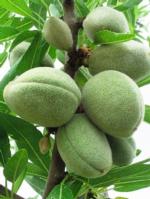Almond
Almonds are stone fruits eaten as nuts. Almonds produced commercially in the United States are grown in California. The earliest to bloom of stone fruits (February). Generally do poorly in North Coast counties. They bloom when weather is cold, rainy. Very susceptible to spring frosts. Almonds do not tolerate wet soils.
The Central Valley and drier regions of southern coast are very favorable for almonds. Trees are very susceptible to bacterial canker disease, which kills trees. Cross-pollination is required; all varieties are self-unfruitful, and some are cross-unfruitful due to incompatibilities.
Almonds are harvested by shaking trees when hulls begin to split. Almonds need 180–240 days to mature the nuts. The nut (embryo and shell) are dried down to a minimum moisture content.
Calendar of Backyard Gardening Operations for Almonds
Winter Dormant Season
- Prune trees in December/January to allow more light into tree, promote growth of new fruiting wood.
- Remove dead, diseased, drooping branches and “suckers” in center of tree.
- Remove, destroy all old nuts on trees and on ground to reduce overwintering navel orangeworms.
- Spray trees with dormant oil to kill peach twig borer, San Jose scale, and mite eggs.
Spring Bloom Season
- Just prior to first irrigation, fertilize mature trees with 2 lb. urea or 30 lb. of manure, water in. Young trees: use small, frequent doses of N throughout the growing season.
- Drip irrigate daily to meet daily tree needs.
- Sprinkler irrigate every 1–3 weeks starting 2–3 weeks after winter rains. Apply 2-3" water/irrigation. Trees growing in shallow or sandy soils need more frequent watering.
Summer Growing Season
- Continue irrigating as during spring bloom season.
- Fertilize trees again at same rate as spring application just prior to last irrigation before harvest. Water in. Nuts are ready for harvest after hulls split and shell is dry and brown.
- Separate hulls from nut and discard. Nuts can be in shell or out.
- Freeze in-shell nuts for 1–2 weeks to kill resident worms.
- Store in plastic bags to prevent reinfestation.
Fall Harvest Season
- Spray trees during or after leaf fall but before onset of winter rains to reduce damage from shot hole fungus the following spring, use fixed copper.
Resources
- Almond Links, UC Fruit and Nut RIC
- [PDF] Almond Varieties for Planting in the Home Garden, Paul Vossen and Deborah Silver, Sonoma and Marin Co. UCCE
- [PDF] Harvesting and Storing Your Home Orchard's Nut Crop: Almonds, Walnuts, Pecans, Pistachios, and Chestnuts, Ed Perry, Stanislaus Co. UCCE and Steve Sibbett, Tulare Co. UCCE
- How to Manage Pests in Gardens and Landscapes - Fruits and Nuts, UC IPM
- [PDF] Producing Quality Almonds: Food Safety Starts on the Farm, Bruce Lampinen, Joe Connell, Almond Board of California
- [PDF] Almonds: Calendar of Operations for Home Gardeners, Pamela M. Geisel and Carolyn L. Unruh, Fresno County and Paul Vossen, Sonoma and Marin County
